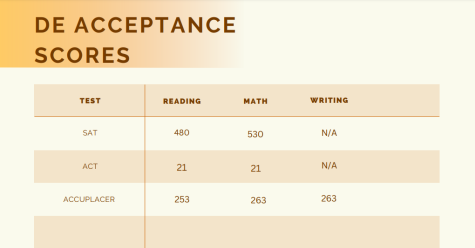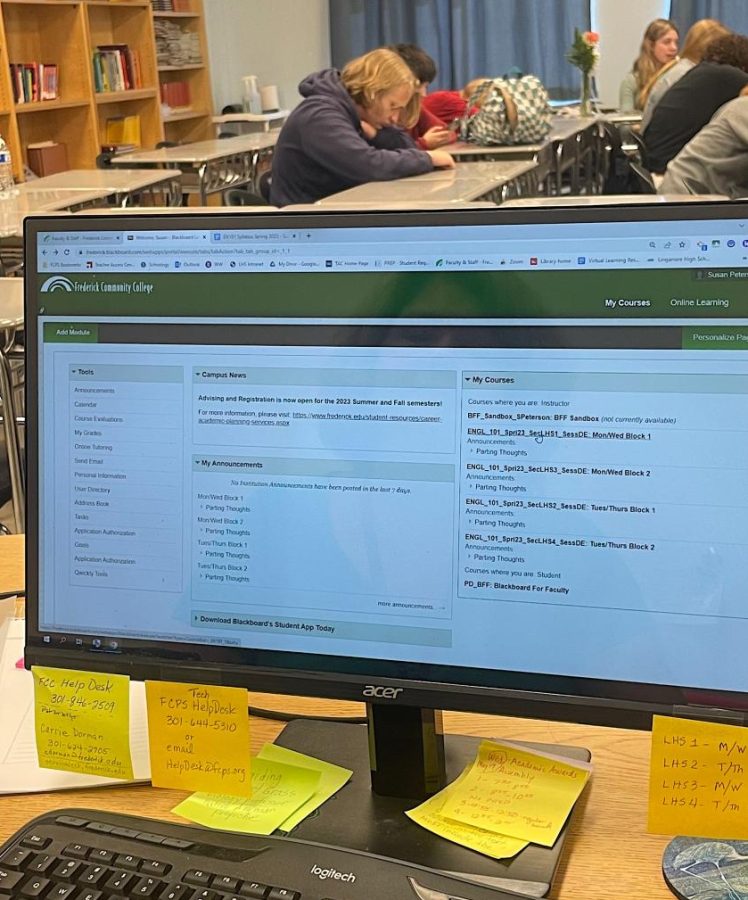Your donation will support the student journalists of Linganore High School. Your contribution will allow us to purchase camera/recording equipment and software. We hope to raise enough money to re-start a monthly printed issue of our paper.
Dual enrollment classes: helping students get ahead or leaving them behind?
May 30, 2023
Blackboard is the program used for dual enrollment classes, which is the same learning management system used by colleges and differs from Schoology, the system utilized by FCPS.
In the last couple years, a new program for students has emerged in high schools across the U.S. called Dual Enrollment. This is a program that allows high school students to work toward a high school diploma while simultaneously achieving college credits.
In simple terms, students will sign up and choose to either attend the local community college for their dual enrollment classes, or they will take them at the high school they attend.
In Frederick County Public Schools (FCPS), students may take these classes on the Frederick Community College (FCC) campus. If students choose to take the college courses at the local college, they will go there during the school day for just those select classes; however, a shuttle service is not offered to students who choose to do so, and they must provide their own transportation.
For students who choose to take the college course at their high school, teachers at those schools are approved by FCC and provided the college course curriculum to teach from their normal classrooms.
There is a final option for students to take dual enrollment courses virtually, meaning they have their coursework solely online and a teacher is for guidance, not intruction.
No matter where they are taken, dual enrollment classes provide credits at both the highschool and college levels.
Linganore High School counselor and dual enrollment advisor Katherine Becker describes this program as “a great bridging opportunity for students interested in attending college.”
The classes are structured almost identically to those offered at the college and university level. The only difference is they are available to students in high school.
This option proves quite beneficial for many students, specifically those who plan to attend college. For example, regardless of the type of degree a student is working toward, they are able to earn college credits in high school, which will propel them ahead and possibly reduce the number of classes required for their bachelor’s degree.
Another benefit for students is that many can save money by taking the classes in high school, rather than college, because some school systems will cover the cost of the dual enrollment classes.
Linganore dual enrollment math teacher Jennifer Weiss said, “it’s really a win-win for students … they get a taste of college and credits while still having a high school support system.”
Starting in the 2023-2024 school year, FCPS will be covering the cost for all dual enrollment classes for students. This helps students financially, as they can get some of their general education credits out of the way while they are still in high school and save the significant expense of college credits. This can allow them to be in college for a shorter period of time or be able to take classes in which they are more interested.
Further benefits of these classes are the opportunities they open up for highly-able learners.
Oftentimes, students who are highly advanced in classes reach a stagnant point in their learning. Providing these students with the ability to continue advancing their education into the college level without taking away their high-school experience drastically improves the system.
Perhaps the most beneficial aspect of this program is that it follows an almost exact model of college academics, from attending class two times a week, communicating strictly between teacher and student and following a college grading system and expectations.
This program allows students to experience what college courses may be like while in the comfortable, controlled environment of their high school.
Although there are numerous benefits to dual enrollment classes, there can be negative aspects as well.
The appeal for many students is that the classes, like college, are only two days a week. Although many students interpret this to mean less school time, that is not the case, as the expectation is for students to completing their coursework on the days they do not have class.
Due to this misconception that classes meeting less frequently are easier, many students sign up and are dangerously unprepared or unwilling to do the work required.
Becker strongly believes that dual enrollment courses are highly beneficial for students, but they must be willing to work hard and truly earn the credit.
“I wouldn’t call it a disadvantage [of the program], but I think many students are very unprepared going into it,” Becker said. “Students are able to withdraw from classes easily, and many choose to do that, [which ends up] teaching them nothing.”
Linganore dual enrollment student Merideth Baker concurred.
“The class had much more work than I expected … some students even dropped out of our class because of it [the workload],” Baker said.
Tess Engel, another student at Linganore taking dual enrollment, expressed similar concerns and acknowledged the level of independent work required for dual enrollment courses.
“The hardest part about [dual enrollment] class was the independent studying required and the final exam to pass the class,” Engel said. “The class was not too much harder than I expected, only because my teacher set clear expectations for us [students] early in the class.”
The importance of students knowing both the expectations and work load required of these college-level classes before going into them is evident. This is necessary for student success, particularly as more and more students enroll in such courses.
Becker shared that dual enrollment classes have become increasingly popular at Linganore. Becker tributes the increase in interest to students recognizing they can receive numerous college credits by taking the courses.
In Frederick County specifically, the rate of students taking dual enrollment classes is rapidly ascending every year. The percentage of students taking dual enrollment courses in Frederick County is over 10%, the second-highest rate below Garrett County.
Furthermore, in Frederick County, dual enrollment students are spread out amongst all grade levels. This differs from most Maryland counties where juniors and seniors make up all of their enrollment.
Dual enrollment also provides a better guarantee of college credit when compared to Advanced Placement (AP) classes. To receive college credit for AP classes, the student must pass an exam with a 3 or higher, depending on the college. Even then, some colleges and univiersities may not even award college credit for these courses. On the other hand, as long as students pass a dual enrollment class with a C or higher, the credits will be accepted within their state.
In the state of Maryland, dual enrollment credits are guaranteed in all public and state-aided independent colleges within Maryland.
With this increase in popularity, however, many educators of these courses fear the success of the classes and the students enrolling in them. Some find that students taking dual enrollment courses are extremely unprepared for the academic rigor and lack the habits of work required to be successful.
These educators also believe that a problem lies within the admission process itself. At this time, almost any student can take dual enrollment courses.
Currently, in most schools, dual enrollment advisors will review GPAs, SAT scores, ACT scores or ACCUPLACER test scores to determine who may be admitted into the dual enrollment program. This leaves room for many unprepared students to be allowed into the program.

In Frederick County, dual enrollment students are spread out amongst all grade levels. This differs from most Maryland counties where juniors and seniors make up all of their enrollment. This data poses the question of whether or not preparedness and success of students can be attributed to grade level.
Susan Peterson, a dual enrollment teacher at Linganore High School, has taught FCC English 101 for two years now and has a strong opinion about the dual enrollment program.
“These classes model the way a college is set up … specifically the time spent working independently,” Peterson said. “Some students find this difficult and struggle to stay motivated without having class everyday.”
Weiss added the sentiment that “students need to self advocate to be successful, just like in college.”
Peterson also voiced concerns about students being unprepared or unwilling to take these dual enrollment courses and suggested a possible solution: teacher recommendations.
According to Peterson, “[a teacher recommendation] would show the work habits of the student and whether or not they are highly-motivated learners” who would be successful in dual enrollment courses.
She believes that although it would add to teachers’ workload, it could “help students understand that dual enrollment classes are not just regular high school classes.”
Dual enrollment has become much more popular in high schools over the past few years, since it is a better guarantee of college credit as compared to AP classes in which students need to pass an exam that only some schools will accept for credit. However, if some restrictions are not put in place to prevent unprepared students from entering the dual enrollment courses, students will face challenges to their success and fail to earn that college credit.

